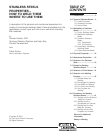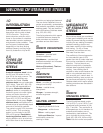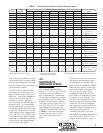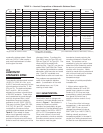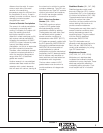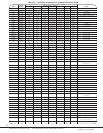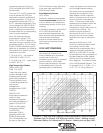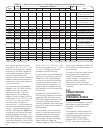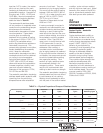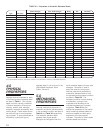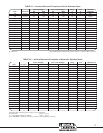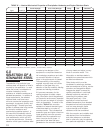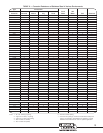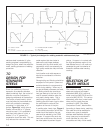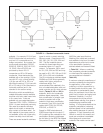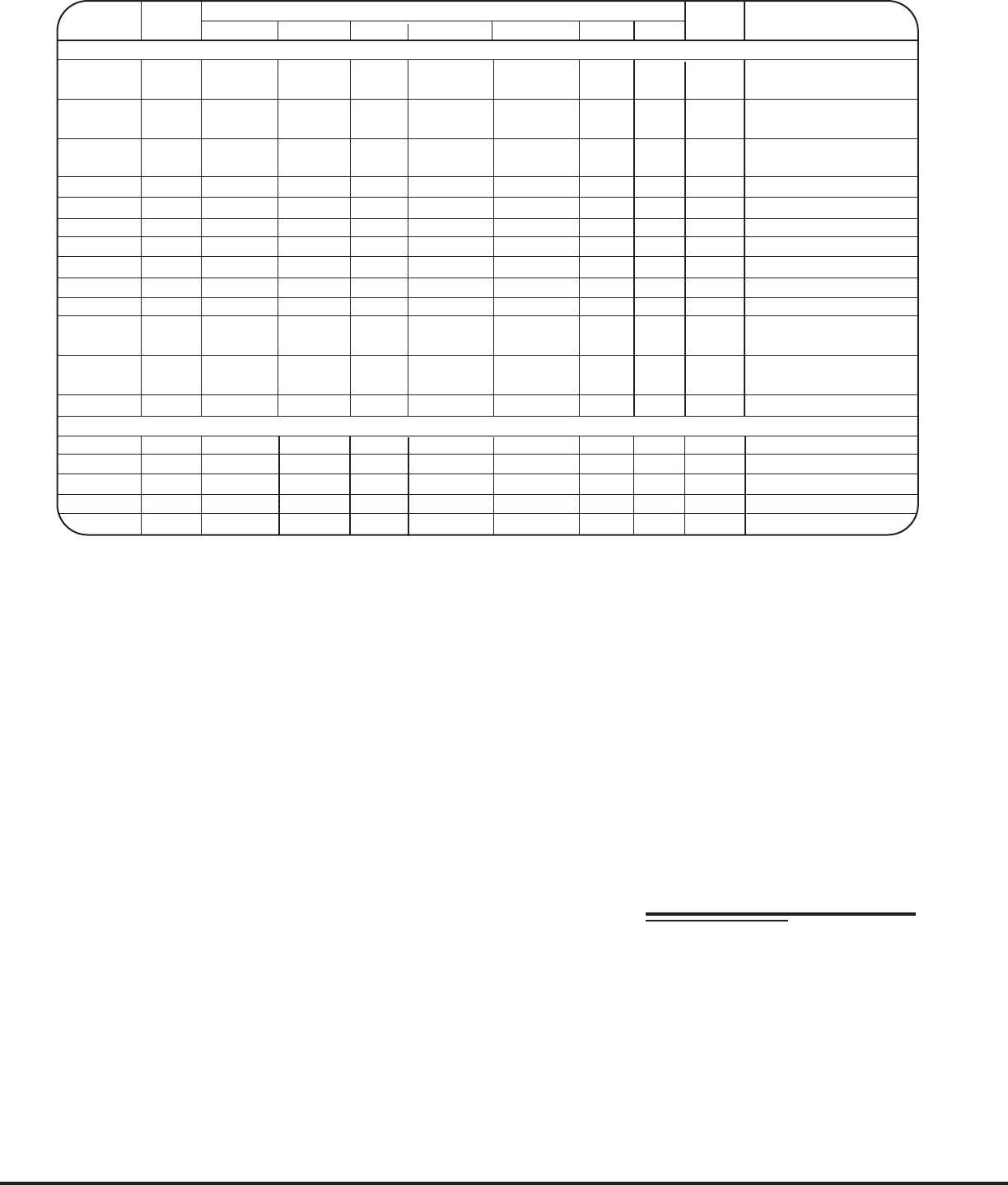
8
the horizontal axis and the nickel
equivalent (% Ni + 30 x % C + 0.5 x
% Mn) on the vertical axis. Despite
long use, the Schaeffler Diagram is
now outdated because it does not
consider nitrogen effects and
because it has not proven possible to
establish agreement among several
measurers as to the ferrite percent in
a given weld metal.
An improvement on the Schaeffler
Diagram is the 1973 WRC-DeLong
Diagram, which can be used to
estimate ferrite level. The main
differences are that the DeLong
Diagram includes nitrogen (N) in the
Ni equivalent (% Ni + 30 x % C x 30
x % N + 0.5 x % Mn) and shows
Ferrite Numbers in addition to
“percent ferrite.” Ferrite Numbers at
low levels may approximate “percent
ferrite.” The most recent diagram,
the WRC-1992 Diagram, Figure 2, is
considered to be the most accurate
predicting diagram at present. The
WRC-1992 Diagram has replaced the
WRC-DeLong Diagram in the ASME
Code with publication of the 1994-95
Winter Addendum. Its Ni equivalent
(% Ni + 35 x % C + 20 x % N + 0.25
Cu) and Cr equivalent (% Cr + % Mo
+ 0.7 x % Cb) differ from those of
Schaeffler and WRC-DeLong.
Ferrite Number may be estimated by
drawing a horizontal line across the
diagram from the nickel equivalent
number and a vertical line from the
chromium equivalent number. The
Ferrite Number is indicated by the
diagonal line which passes through
the intersection of the horizontal and
vertical lines.
Predictions by the WRC-1992 and
WRC-DeLong Diagrams for common
grades like 308 are similar, but the
WRC-1992 diagram generally is more
accurate for higher alloy and less
common grades like high manganese
austenitic or duplex ferritic-austenitic
stainless steels.
Ferrite Number can be measured
directly on weld deposits from the
magnetic properties of the ferrite.
Several instruments are available
commercially, including the Magne
Gage, the Severn Gage, the
Inspector Gage and the Ferritescope
which can be calibrated to AWS A4.2
or ISO 8249 and provide readings in
Ferrite Number.
The amount of ferrite normally should
not be greater than necessary to
prevent hot cracking with some
margin of safety. The presence of
ferrite can reduce corrosion
resistance in certain media and
excess ferrite can impair ductility and
toughness.
3.4
PRECIPITATION
HARDENING
STAINLESS STEELS
There are three categories of precipi-
tation hardening stainless steels –
martensitic, semiaustenitic and
austenitic.
The martensitic stainless steels can
be hardened by quenching from the
austenitizing temperature [around
1900°F (1038°C)] then aging
between 900 to 1150°F (482 to
621°C). Since these steels contain
UNS Composition - Percent *
Type Number C Mn Si Cr Ni PS Other
Precipitation-Hardening Types
PH 13-8 Mo S13800 0.05 0.10 0.10 12.25-13.25 7.5-8.5 0.01 0.008 2.0-2.5 Mo;
0.90-1.35 Al; 0.01 N
15-5 PH S15500 0.07 1.00 1.00 14.0-15.5 3.5-5.5 0.04 0.03 2.5-4.5 Cu;
0.15-0.45
Nb(Cb)
+ Ta
17-4 PH S17400 0.07 1.00 1.00 15.5-17.5 3.0-5.0 0.04 0.03 630 3.0-5.0 Cu;
0.15-0.45
Nb(Cb)
+ Ta
17-7 PH S17700 0.09 1.00 1.00 16.0-18.0 6.5-7.75 0.04 0.03 631 0.75-1.15 Al
PH 15-7 Mo S15700 0.09 1.00 1.00 14.0-16.0 6.5-7.75 0.04 0.03 2.0-3.0 Mo; 0.75-1.5 Al
17-10 P 0.07 0.75 0.50 17.0 10.5 0.28
A286 S66286 0.08 2.00 1.00 13.5-16.0 24.0-27.0 0.040 0.030 660 1.0-1.5 Mo; 2 Ti; 0.3 V
AM350 S35000 0.07-0.11 0.5-1.25 0.50 16.0-17.0 4.0-5.0 0.04 0.03 2.5-3.25 Mo; 0.07-0.13 N
AM355 S35500 0.10-0.15 0.5-1.25 0.50 15.0-16.0 4.0-5.0 0.04 0.03 2.5-3.25 Mo
AM363 0.04 0.15 0.05 11.0 4.0 0.25 Ti
Custom 450 S45000 0.05 1.00 1.00 14.0-16.0 5.0-7.0 0.03 0.03 1.25-1.75 Cu; 0.5-1.0 Mo
8 x %C -
Nb(Cb)
Custom 455 S45500 0.05 0.50 0.50 11.0-12.5 7.5-9.5 0.04 0.03 0.5 Mo; 1.5-2.5 Cu;
0.8-1.4 Ti; 0.1-0.5
Nb(Cb)
Stainless W S17600 0.08 1.00 1.00 16.0-17.5 6.0-7.5 0.04 0.03 0.4 Al; 0.4-1.2 Ti
Duplex Types
2205 S32205 0.03 2.0 1.0 22.0 5.5 0.03 0.02 3.0 Mo; 0.18 N
2304 S32304 0.03 2.5 1.0 23.0 4.0 0.1 N
255 0.04 1.5 1.0 25.5 5.5 3.0 Mo; 0.17 N; 2.0 Cu
NU744LN 0.067 1.7 0.44 21.6 4.9 2.4 Mo; 0.10 N; 0.2 Cu
2507 S32750 0.03 1.2 0.8 25 5.5 0.035 0.020 4 Mo; 0.28 N
TABLE IV — Nominal Compositions of Precipitation Hardening and Duplex Stainless Steels
*Single values are maximum values. (From ASM Metals Handbook, Ninth Edition, Volume 3) and ASTM A638
ASTM
A
GRADE




